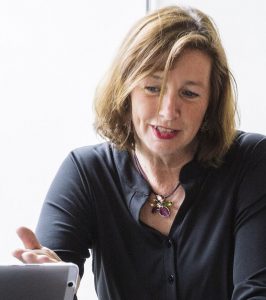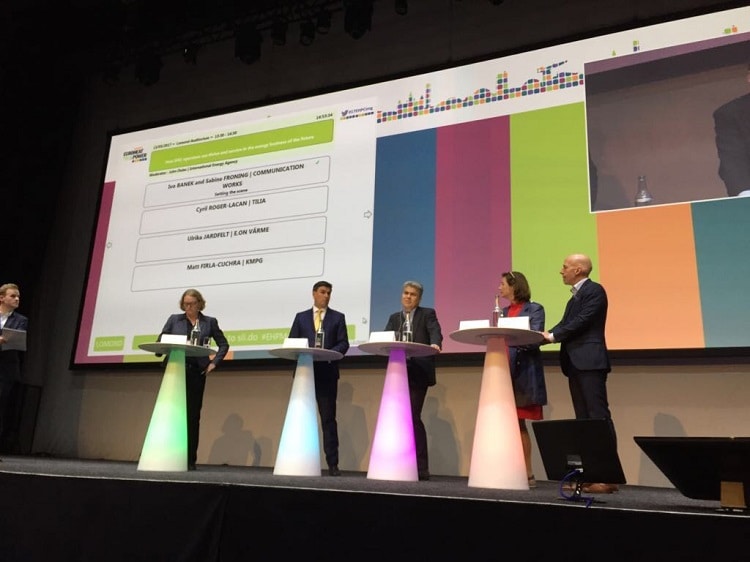District Heating in the UK
Cities in the UK shall replace gas boilers by District Heating networks, but the technology is met by strong reservations. How to overcome them? Sabine Froning, District Heating expert at Communication Works, just attended the Euroheat & Power Congress in Glasgow, where she shared some ideas how District Heating can thrive and survive in the future.
29. May 2017

What makes District Heating in the UK a hot topic for Communication Works?
In the UK, District Heating is fairly unknown and only has a share of about two percent of heating systems. The British government wants to promote heat networks as a means for climate protection. To get there, you need to convince many people of the benefits of this technology: city councillors, house owners, tenants – a fantastic communicative challenge!
Why would District Heating be a good solution for the UK?
Heating is the largest final energy use and still largely based on fossil fuels. But oil and gas boilers will need to totally disappear pretty fast, if we want to keep climate change in check. This is an enormous opportunity for District Heating, in particular when it comes to densely populated areas. It allows to harness all kinds of waste heat which otherwise would remain unused and to scale up renewable solutions.
District Heating seems to be well established on the continent. Why not in the UK?
In many countries on the continent District Heating is a well-known solution to heat homes. Especially with the oil crisis in the 70s and 80s it has gained recognition as an energy-efficient alternative to oil and gas boilers and attained double-digit market shares. In the UK, which unlike most countries has own gas resources, District Heating has never really taken off.
So what is the recipe to change this and make the Brits go for District Heating in the future?
You need to win the hearts and minds of the people. Otherwise you won’t get very far – despite the political will. Utilities and municipalities can no longer make decisions on people’s behalf, they must involve them. Citizens and customers are not just a homogeneous mass. The very first step is to listen carefully and to find out what is relevant for each group.
Why not simply tell them the advantages, as you just described them?
In a liberalised and decentral energy world where people become more and more interested in generating their own energy, all larger scale solutions are struggling for acceptance. The fact that in a District Heating network you depend on a single supplier and have little influence on price or on how the energy is produced, is a show stopper in the opinion of many people. And before telling anyone anything, it’s good to understand what the recipient’s interests actually are.

Sabine Froning and Ivo Banek (right) at the panel in Glasgow
At the conference in Glasgow, you and Ivo Banek presented some ideas how to respond to negative perceptions.
Communication Works has conducted two workshops with the Association for Decentralised Energy, which represents the District Energy sector in the UK, to explore possible actions to mitigate negative views: What can District Heating operators offer, how can they reach out to future customers and what can they say? The scenarios that we have developed together with their experts have been surveyed with a representative sample of the UK population, based on a scientific method that Communication Works has developed with the Stockholm School of Economics.
What were the results?
We found interesting options for each age group in the areas of pricing, participation and sustainability. What surprised us most was that although people really care a lot about the price, it’s not customer protection measures and regulation that would make them change their view. More effective are other benefits for the community which improve the social and environmental quality of life.
How can companies use your model for business planning and participation?
Energy companies are used to make decisions from an energy system point of view and often are afraid to let non-experts in. Our method allows them to challenge their own beliefs, to discover what expectations are out there and to understand how they can use these to improve their business models to everybody’s advantage. But the analysis is only the first step in what we call “Community Scouting“. The next steps are to develop a communication and engagement strategy from there, and that’s what Communication Works thrives most at.
You have been part of the European District Heating community for many years. What are your personal take-aways from the conference in Glasgow?
First and foremost it was great to reconnect with so many colleagues and friends. Luckily, it is a very stable community of District Heating enthusiasts, so I recognised many. But there were many new faces as well, which I take as a sign that the sector keeps growing and renewing itself. Then, as it was my first time in Scotland, I enjoyed the wonderful impressions from the Scottish people and culture, especially the openness and friendly directness.
Download a preliminary version of the report
Watch Sabine Froning and Ivo Banek in Glasgow

Communication Works’ presentation in Glasgow